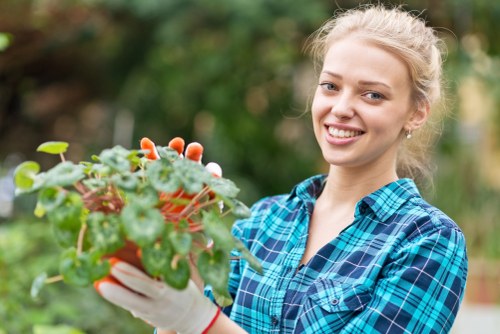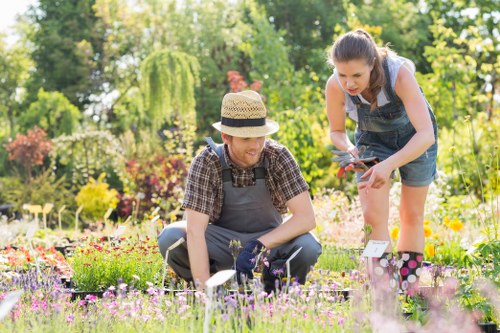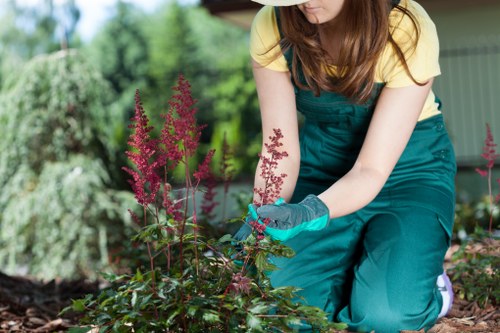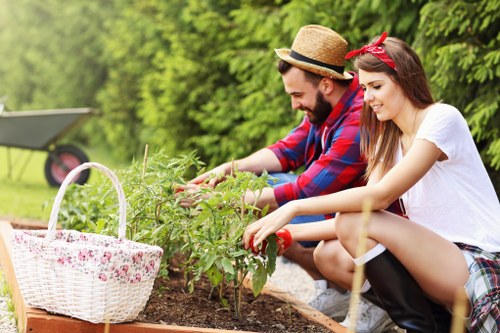Gardener Woodlands

Gardener Woodlands offer a serene and enchanting environment that appeals to both seasoned gardeners and nature enthusiasts alike. Nestled amidst lush greenery, these woodlands provide the perfect backdrop for cultivating a variety of plants, flowers, and trees. Whether you're looking to create a tranquil retreat or a vibrant garden space, understanding the unique aspects of woodland gardening can help you achieve your vision.
Woodland gardens are characterized by their shaded areas, rich soil, and diverse plant life. These elements create a harmonious ecosystem where plants thrive naturally, often without the need for extensive maintenance. By embracing the natural beauty of woodlands, gardeners can develop sustainable and aesthetically pleasing landscapes that enhance the surrounding environment.
In this article, we will delve into the essential components of woodland gardening, explore popular plant choices, and provide practical tips for designing and maintaining your own woodlands garden. We will also highlight the benefits of woodland gardening and discuss nearby areas that are perfect for gardeners looking to explore and expand their green spaces.
The Beauty of Woodlands Gardening

Woodlands gardening is a unique approach that leverages the natural advantages of wooded areas to create beautiful and resilient gardens. Unlike traditional gardens that require ample sunlight and regular maintenance, woodland gardens thrive in shaded or partially shaded conditions. This makes them ideal for areas with limited sunlight or for gardeners who prefer low-maintenance landscapes.
The charm of woodland gardens lies in their ability to mimic the natural environment. By selecting plants that are native or well-suited to the local climate, gardeners can create a sustainable and diverse ecosystem. This not only enhances the visual appeal of the garden but also supports local wildlife, including birds, butterflies, and beneficial insects.
Moreover, woodland gardens often incorporate elements such as mosses, ferns, and groundcovers that add texture and depth to the landscape. These plants contribute to a layered effect, creating a sense of tranquility and harmony that is both soothing and visually captivating.
Key Elements of a Woodland Garden

Successful woodland gardening hinges on understanding and integrating several key elements. These include:
- Shade-Tolerant Plants: Selecting plants that thrive in low-light conditions is crucial. These plants are adapted to the dappled sunlight and varying levels of shade typical of woodlands.
- Rich, Well-Drained Soil: Woodlands often have nutrient-rich soil that supports a variety of plant life. Ensuring proper soil structure and drainage helps prevent waterlogging and promotes healthy root systems.
- Diverse Plant Selection: Incorporating a mix of trees, shrubs, perennials, and groundcovers creates a layered and dynamic garden. Diversity not only enhances visual interest but also supports a wide range of wildlife.
- Natural Pathways: Creating pathways using natural materials like wood chips, gravel, or stepping stones allows for easy navigation while maintaining the garden's natural aesthetic.
- Water Features: Adding elements such as ponds, streams, or birdbaths can attract wildlife and create focal points within the garden.
By thoughtfully integrating these elements, gardeners can craft a woodland garden that is both beautiful and sustainable.
Popular Plants for Woodlands

Choosing the right plants is essential for the success of a woodland garden. Here are some popular options:
- Hostas: Known for their lush foliage and variety of colors, hostas are a staple in woodland gardens. They thrive in shaded areas and provide a soft, textured look.
- Ferns: Ferns add a delicate, feathery contrast to other plants. They are excellent for groundcover and thrive in moist, shaded environments.
- Impatiens: These vibrant flowers bring a splash of color to the garden. They are shade-loving and bloom throughout the summer months.
- Camellias: Offering evergreen foliage and beautiful blooms, camellias provide year-round interest and thrive in the mild shade of woodlands.
- Japanese Maple: With their striking foliage and graceful form, Japanese maples serve as stunning focal points in woodland gardens.
- Wood Anemone: These charming wildflowers add a touch of elegance with their delicate, star-shaped blooms in the spring.
Incorporating a variety of these plants can create a vibrant and harmonious woodland garden that appeals to the senses.
Designing Your Woodland Garden

Designing a woodland garden involves careful planning and consideration of the natural landscape. Here are some tips to help you create a stunning woodland garden:
- Assess the Site: Understand the light levels, soil quality, and existing vegetation. This will guide your plant selection and design strategy.
- Create Layers: Design your garden with multiple layers, including trees, shrubs, perennials, and groundcovers. This adds depth and visual interest.
- Use Natural Materials: Incorporate materials like wood, stone, and gravel to maintain a natural look. These materials blend seamlessly with the woodland environment.
- Add Seating Areas: Incorporate benches or seating areas where you can relax and enjoy the tranquility of your garden.
- Integrate Water Features: Water elements can enhance the sensory experience and attract wildlife, adding to the overall ambiance.
- Emphasize Native Plants: Using native plants promotes sustainability and supports local ecosystems, making your garden more resilient.
By following these guidelines, you can design a woodland garden that is both functional and aesthetically pleasing.
Maintenance Tips for Woodlands Gardens
Maintaining a woodland garden requires less effort compared to traditional gardens, but certain practices help ensure its longevity and beauty:
- Mulching: Apply a layer of mulch to retain moisture, suppress weeds, and enrich the soil.
- Pruning: Regularly prune trees and shrubs to maintain their shape and encourage healthy growth.
- Watering: While woodland gardens are generally low-maintenance, ensure plants receive adequate water during dry spells.
- Weed Control: Monitor for invasive species and remove weeds promptly to prevent them from overtaking your garden.
- Soil Health: Periodically test and amend the soil to maintain its nutrient balance and structure.
Implementing these maintenance practices will help keep your woodland garden thriving and beautiful throughout the year.
Wildlife in Woodlands
One of the joys of woodland gardening is the abundance of wildlife it attracts. Birds, butterflies, bees, and other beneficial insects find shelter and food in these lush environments. By creating a diverse and welcoming habitat, gardeners can support local biodiversity and enjoy the sights and sounds of nature right in their backyard.
To enhance wildlife attraction, consider planting a variety of flowering plants that provide nectar and pollen. Installing birdhouses, bat boxes, and butterfly feeders can also encourage different species to visit and inhabit your garden. Additionally, leaving some natural debris like fallen leaves and logs can create shelter for small animals and insects.
A thriving wildlife population not only adds to the garden's vibrancy but also contributes to the overall health of the ecosystem by promoting pollination and natural pest control.
Benefits of Woodland Gardening
Woodland gardening offers numerous benefits that extend beyond aesthetics:
- Environmental Sustainability: By using native plants and reducing the need for excessive watering and fertilizers, woodland gardens are more sustainable and eco-friendly.
- Mental Well-being: Spending time in a peaceful woodland garden can reduce stress, enhance mood, and improve overall mental health.
- Biodiversity Support: Woodland gardens provide habitats for various species, thereby supporting local biodiversity and ecosystem health.
- Energy Efficiency: Strategically placed trees and shrubs can offer natural insulation, reducing energy consumption for heating and cooling nearby structures.
- Aesthetic Appeal: The natural beauty of woodland gardens enhances the visual landscape, increasing property value and enjoyment.
Embracing woodland gardening not only beautifies your space but also contributes positively to the environment and your personal well-being.
Local Areas Near Woodlands for Gardeners
For gardeners residing in or near Woodlands, there are several surrounding areas that offer unique gardening opportunities and resources. Here are some of the closest areas to Woodlands:
- Maple Grove: Located just 5 miles from Woodlands, Maple Grove is renowned for its extensive public gardens and annual flower festivals.
- Pinehurst: A short 7-mile drive from Woodlands, Pinehurst boasts beautiful pine forests and specialized nurseries that cater to woodland plants.
- Riverbend: Situated 10 miles away, Riverbend features picturesque riverfront gardens and community gardening projects.
- Oakridge: 12 miles from Woodlands, Oakridge offers a variety of native plant species and sustainable gardening workshops.
- Cedar Heights: Located 8 miles away, Cedar Heights is popular for its peaceful walking trails and well-maintained botanical gardens.
- Willow Springs: 6 miles from Woodlands, Willow Springs is known for its vibrant wildflower meadows and educational garden tours.
- Birchwood: A mere 4 miles away, Birchwood features community gardens and seasonal planting events for local gardeners.
- Elm Valley: Situated 9 miles from Woodlands, Elm Valley offers fertile soil ideal for experimenting with diverse plant varieties.
- Fernhill: 11 miles from Woodlands, Fernhill is a hub for fern enthusiasts and hosts annual fern fairs.
- Spruce Meadows: Located 14 miles away, Spruce Meadows is celebrated for its expansive meadows and sustainable gardening practices.
- Palm Grove: 13 miles from Woodlands, Palm Grove provides unique gardening experiences with exotic and native plant combinations.
- Myrtle Lake: 15 miles away, Myrtle Lake is perfect for gardeners interested in aquatic plants and water gardening.
- Hickory Point: Situated 3 miles from Woodlands, Hickory Point offers quick access to local nurseries and garden supply stores.
- Sylvan Park: 2 miles from Woodlands, Sylvan Park is ideal for beginners, with numerous beginner-friendly gardening classes and resources.
- Lavender Fields: Just 1 mile away, Lavender Fields is famous for its fragrant lavender gardens and picturesque landscapes.
Exploring these nearby areas can provide gardeners with inspiration, resources, and community connections to enhance their woodland gardening endeavors.
Conclusion
Gardener Woodlands offer a unique and rewarding approach to cultivating beautiful and sustainable gardens. By understanding the essential elements, selecting the right plants, and practicing mindful maintenance, you can create a woodland garden that not only enhances your living space but also supports local biodiversity and promotes environmental sustainability.
Furthermore, leveraging the resources and inspirations available in nearby areas can enrich your gardening experience and help you connect with a community of like-minded enthusiasts. Whether you're a seasoned gardener or just starting, Woodland Gardens provide an opportunity to embrace nature's tranquility and creativity.
Embark on your woodland gardening journey today, and transform your outdoor space into a lush, vibrant, and serene sanctuary.
Frequently Asked Questions
1. What types of plants are best for woodland gardens?
Plants that thrive in shaded or partially shaded conditions are ideal for woodland gardens. Some popular choices include hostas, ferns, impatiens, camellias, and Japanese maples. These plants are adapted to lower light levels and can flourish in the rich, moist soil typically found in woodlands.
2. How can I maintain a woodland garden with minimal effort?
To maintain a woodland garden with minimal effort, focus on selecting native or low-maintenance plants that require less watering and care. Use mulch to retain moisture and suppress weeds, and implement natural pathways to reduce soil erosion. Regular pruning and occasional soil amendments will also help keep your garden healthy with minimal upkeep.
3. Can I create a woodland garden in a small backyard?
Yes, woodland gardens can be adapted to various garden sizes, including small backyards. Focus on layering plants vertically and using space-efficient species. Incorporate containers or raised beds if necessary, and choose compact plants that still offer the lush, green aesthetic typical of woodlands.
4. What are the benefits of having wildlife in my woodland garden?
Having wildlife in your woodland garden enhances biodiversity and creates a lively, dynamic environment. Birds, butterflies, bees, and beneficial insects contribute to pollination and natural pest control. Additionally, observing wildlife can provide enjoyment and a deeper connection to nature.
5. How do I choose the right location for my woodland garden?
Choose a location that receives partial to full shade, mimicking the natural conditions of a woodland. Ensure the area has well-drained, rich soil and is sheltered from strong winds. Observing the site’s existing vegetation and sunlight patterns will help you select the best spot for your woodland garden.

